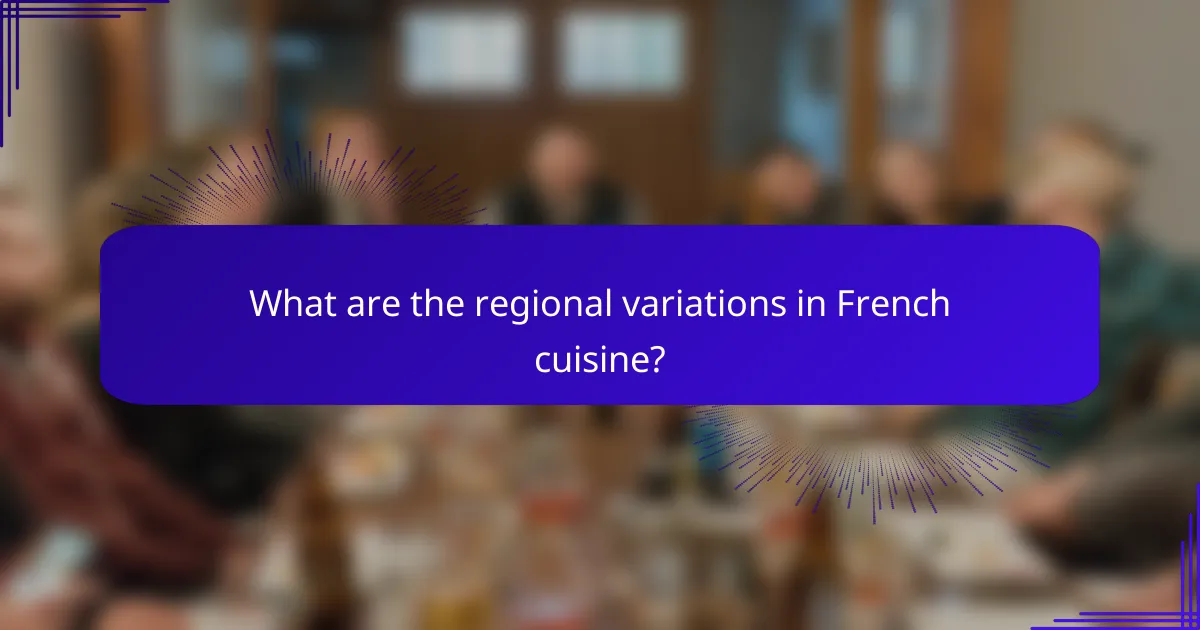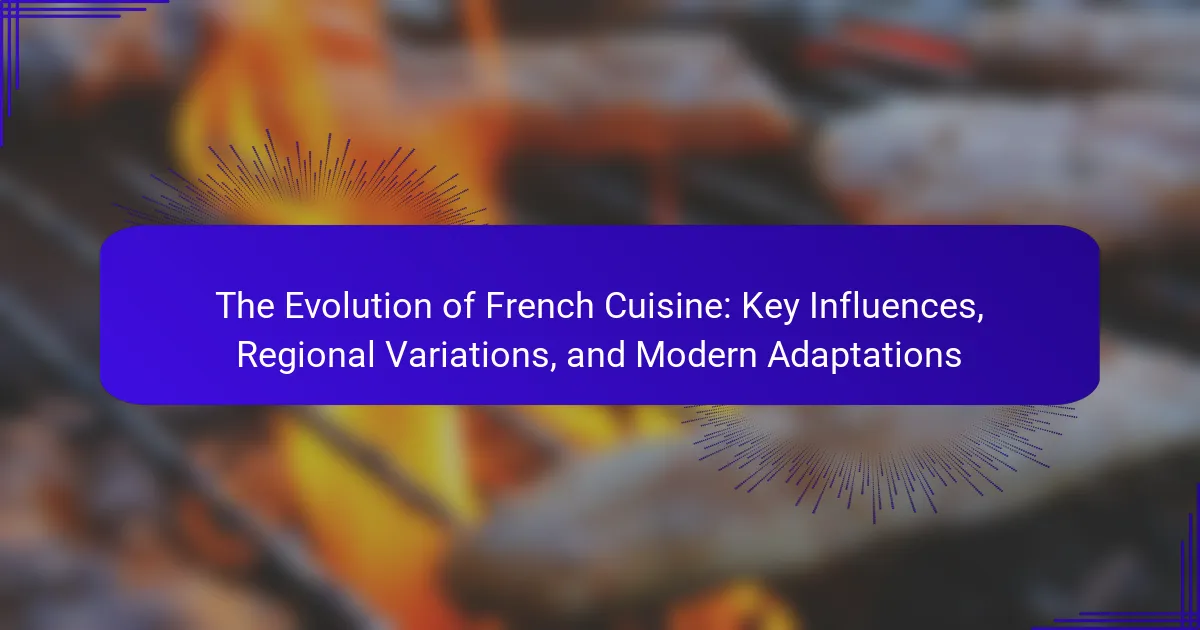
What is the Evolution of French Cuisine?
The evolution of French cuisine reflects a rich history of cultural influences and regional diversity. It began in the Middle Ages with simple, rustic dishes. The Renaissance introduced new ingredients from the Americas, enhancing flavors and techniques. In the 17th century, culinary professionals began to emerge, establishing a foundation for modern French cooking. The 19th century saw the rise of haute cuisine, characterized by elaborate presentations and intricate techniques. The 20th century introduced nouvelle cuisine, emphasizing fresh ingredients and lighter dishes. Today, French cuisine continues to adapt, incorporating global influences while maintaining traditional practices. This ongoing evolution highlights the dynamic nature of French culinary art.
How has French cuisine developed over the centuries?
French cuisine has developed significantly over the centuries, influenced by historical events and cultural exchanges. In the Middle Ages, French cooking focused on hearty, rustic dishes using local ingredients. The Renaissance introduced new spices and techniques from Italy, elevating French culinary practices. The 17th century saw the emergence of haute cuisine, characterized by elaborate presentations and refined techniques. The 19th century brought the establishment of culinary schools, standardizing French cooking methods. In the 20th century, chefs like Auguste Escoffier modernized cuisine, emphasizing simplicity and quality ingredients. Today, French cuisine continues to evolve, blending traditional methods with global influences and modern dietary preferences.
What are the key historical milestones in French culinary history?
The key historical milestones in French culinary history include the establishment of haute cuisine in the 17th century. This period marked the transition from medieval cooking styles to refined techniques. The publication of “Le Cuisinier François” by François Pierre La Varenne in 1651 standardized French cooking methods. The 19th century saw the rise of restaurant culture, significantly influenced by chefs like Auguste Escoffier. Escoffier’s work in the late 1800s modernized French cuisine with the brigade system. The 20th century introduced nouvelle cuisine, emphasizing fresh ingredients and lighter dishes. The 1980s and 1990s brought a focus on regional specialties and sustainable practices. Each milestone reflects the evolution and global influence of French cuisine.
How did social and political changes influence French cuisine?
Social and political changes significantly influenced French cuisine throughout history. The French Revolution in the late 18th century led to the rise of a new middle class. This shift democratized food and dining, making previously elite culinary practices more accessible. The establishment of culinary schools in the 19th century standardized cooking techniques and elevated the profession of chefs. Additionally, the introduction of new ingredients and cooking methods from colonies expanded the French culinary repertoire. Political changes often dictated food availability and preparation, as seen with wartime rationing affecting ingredient choices. Overall, these social and political dynamics shaped the evolution, diversity, and accessibility of French cuisine.
What are the main influences on French cuisine?
French cuisine is primarily influenced by geography, history, and cultural exchange. The diverse regions of France contribute unique ingredients and cooking techniques. For example, coastal areas emphasize seafood, while mountainous regions focus on hearty dishes. Historical events, such as the Renaissance, introduced new ingredients like tomatoes and chocolate. Additionally, cultural exchanges from trade and colonization brought spices and culinary practices from around the world. The French Revolution also impacted cuisine by democratizing food access and leading to the rise of bistros. Overall, these influences shape the rich tapestry of French culinary traditions.
How did geography shape the ingredients used in French cooking?
Geography significantly influenced the ingredients used in French cooking. The diverse landscapes of France created distinct regional climates. These climates allowed for the growth of various crops and livestock. For example, the Mediterranean region produced olives and citrus fruits. In contrast, the northern regions focused on grains and dairy. Proximity to the sea facilitated access to fresh seafood in coastal areas. The mountainous regions provided unique herbs and game. Historical trade routes also introduced exotic spices and ingredients. Thus, geography shaped a rich tapestry of flavors in French cuisine.
What role did trade and exploration play in the evolution of French cuisine?
Trade and exploration significantly influenced the evolution of French cuisine. These activities introduced new ingredients and cooking techniques to France. Spices from the East, such as pepper and cinnamon, became popular in French dishes. The Columbian Exchange brought tomatoes, potatoes, and chocolate to France from the Americas. These new foods transformed traditional French recipes and expanded culinary possibilities. Trade routes also facilitated cultural exchanges, leading to the adoption of diverse cooking styles. The influence of Italian cuisine during the Renaissance exemplifies this blending of culinary traditions. Overall, trade and exploration were crucial in shaping the rich tapestry of French culinary heritage.

What are the regional variations in French cuisine?
French cuisine exhibits notable regional variations influenced by local ingredients, traditions, and cultural practices. In Provence, Mediterranean flavors dominate with olive oil, herbs, and seafood. The cuisine of Brittany features abundant seafood and crepes, reflecting its coastal geography. In Alsace, German influences are evident in dishes like choucroute garnie, which includes sauerkraut and sausages. The rich, creamy dishes of Normandy often incorporate dairy and apples, showcasing local produce. In the mountainous regions, hearty fare includes dishes like tartiflette, made with potatoes and cheese. Each region’s unique climate and agricultural practices shape its culinary identity. These variations highlight the diversity of French cuisine, making it a reflection of the country’s geography and culture.
How do different regions of France contribute unique flavors?
Different regions of France contribute unique flavors through their distinct agricultural products and culinary traditions. For example, Provence is known for its herbs, olive oil, and tomatoes, which create vibrant Mediterranean dishes. In contrast, Normandy offers rich dairy products, particularly cream and butter, essential for its famous sauces and desserts. The coastal regions, such as Brittany, provide an abundance of seafood, influencing local recipes with fresh fish and shellfish. Alsace is recognized for its Germanic influences, featuring hearty dishes with sauerkraut and sausages. Each region’s climate, soil, and cultural history shape its specific ingredients and cooking methods. This diversity is reflected in traditional recipes that have been passed down through generations, showcasing local flavors and techniques.
What are the signature dishes of Northern France?
Signature dishes of Northern France include moules-frites, carbonnade flamande, and tarte au sucre. Moules-frites features mussels cooked in white wine served with fries. Carbonnade flamande is a beef stew made with beer, onions, and spices. Tarte au sucre is a sweet pie made with cream and sugar. These dishes reflect the region’s coastal and agricultural influences. They showcase local ingredients like seafood and beef. Historical ties to Belgium also influence these culinary traditions. Each dish has unique preparation methods and flavor profiles.
How does Southern French cuisine differ from Northern cuisine?
Southern French cuisine emphasizes fresh vegetables, herbs, and olive oil, while Northern cuisine relies more on butter, cream, and hearty ingredients. The South features Mediterranean influences, including seafood and light dishes. In contrast, the North showcases richer, meat-based meals and stews. Provençal dishes often include ratatouille and bouillabaisse, highlighting local produce. Northern specialties include coq au vin and tarte flambée, reflecting its agricultural history. The climate also affects these cuisines; the South’s warm weather supports diverse crops. Meanwhile, the North’s cooler climate favors root vegetables and grains. These regional differences illustrate the broader evolution of French cuisine.
What are the culinary traditions associated with specific regions?
French culinary traditions vary significantly by region. Each area showcases distinct ingredients and cooking methods. For example, Provence is known for its use of olive oil, herbs, and fresh vegetables. The region emphasizes Mediterranean flavors and seasonal produce. In contrast, Normandy features dairy products, apples, and seafood. Its cuisine often highlights cream and cider.
Brittany is famous for its crêpes and seafood dishes, reflecting its coastal location. The Alsace region blends French and German influences, with hearty sausages and sauerkraut. Burgundy is renowned for its wines and rich sauces, utilizing local meats and mushrooms.
The Auvergne region is noted for its cheeses and rustic dishes, often featuring potatoes and meats. Each of these regional traditions contributes to the overall diversity of French cuisine. This regional variation has evolved over centuries, influenced by geography, climate, and culture.
How do local ingredients influence regional cooking styles?
Local ingredients significantly shape regional cooking styles. They determine flavor profiles, cooking techniques, and dish compositions. For instance, coastal regions utilize seafood, while inland areas may focus on meats and dairy. The availability of fresh produce influences seasonal dishes. In Provence, herbs like thyme and rosemary are prevalent due to the Mediterranean climate. Similarly, Brittany is known for its use of buckwheat in galettes. Historical trade routes also introduced new ingredients, further diversifying local cuisine. Regional specialties often reflect agricultural practices and local traditions. This connection between local ingredients and cooking styles fosters culinary identity.
What are the traditional cooking methods used in various regions?
Traditional cooking methods used in various regions include roasting, boiling, steaming, and frying. Roasting is prevalent in regions like Provence, where meats and vegetables are cooked over an open flame. Boiling is commonly used in areas like Normandy for preparing dishes such as apple cider stew. Steaming is a method found in Brittany, often employed for seafood dishes like mussels. Frying is widely practiced in regions like Alsace, where crispy dishes are a staple. Each method reflects local ingredients and cultural preferences, showcasing the diversity of French cuisine.

What are the modern adaptations of French cuisine?
Modern adaptations of French cuisine include fusion dishes, plant-based options, and simplified techniques. Chefs often blend French cooking with global flavors. This trend enhances traditional recipes with diverse ingredients. Plant-based adaptations reflect growing dietary preferences. Classic dishes are reimagined using vegan or vegetarian substitutes. Techniques have also evolved, focusing on efficiency and accessibility. Sous-vide cooking and molecular gastronomy are popular among contemporary chefs. These adaptations maintain the essence of French culinary art while appealing to modern tastes.
How has globalization affected French culinary practices?
Globalization has significantly influenced French culinary practices by introducing diverse ingredients and cooking techniques. French cuisine has incorporated flavors from around the world, enhancing traditional dishes. For instance, spices from Asia and herbs from the Americas have become more prevalent in French cooking. The rise of fusion cuisine exemplifies this blending of culinary traditions. Additionally, international food trends have shaped French dining experiences. Fast-casual dining and food trucks, popularized globally, have emerged in France. Furthermore, globalization has increased the availability of international products in French markets. This has allowed chefs to experiment with global flavors while maintaining French culinary techniques. As a result, French cuisine continues to evolve, reflecting a more interconnected world.
What are some contemporary trends in French cuisine today?
Contemporary trends in French cuisine today include a focus on sustainability and local ingredients. Chefs are increasingly prioritizing seasonal produce. This approach enhances flavors and reduces carbon footprints. Plant-based dishes are gaining popularity among diners. Many restaurants now offer vegan and vegetarian options. Fusion cuisine is also on the rise, blending French techniques with global flavors. Additionally, there is a trend toward casual dining experiences. Fine dining establishments are adopting a more relaxed atmosphere. These shifts reflect changing consumer preferences and lifestyles.
How have chefs innovated traditional French dishes for modern palates?
Chefs have innovated traditional French dishes by incorporating global flavors and modern cooking techniques. They often use local and seasonal ingredients to enhance freshness. For example, classic coq au vin may feature organic chicken and a lighter red wine. Sous-vide cooking methods allow for precise temperature control, improving texture. Chefs also adapt traditional recipes to cater to dietary preferences, such as gluten-free or vegan options. Plating has become more artistic, emphasizing visual appeal alongside flavor. The use of molecular gastronomy introduces unexpected textures and presentations. These innovations reflect changing consumer tastes and a desire for healthier options. Overall, the evolution of French cuisine demonstrates adaptability while maintaining its rich heritage.
What fusion cuisines have emerged from French culinary traditions?
French culinary traditions have given rise to several fusion cuisines. Notable examples include Franco-Mexican cuisine, which blends French techniques with Mexican flavors. Another example is Franco-Asian cuisine, combining French cooking styles with Asian ingredients and dishes. Additionally, Franco-Italian cuisine merges the rich flavors of Italian food with French culinary practices. These fusion cuisines showcase the adaptability and global influence of French culinary arts.
How do cultural exchanges influence modern French cooking?
Cultural exchanges significantly influence modern French cooking by introducing diverse ingredients and techniques. Globalization has facilitated the incorporation of flavors from various cuisines. For example, Asian spices and cooking methods have become popular in French kitchens. The fusion of culinary traditions has led to innovative dishes that reflect multicultural influences. Chefs often travel abroad, gaining inspiration from international culinary practices. This cross-pollination results in a dynamic culinary landscape in France. Historical trade routes also contributed to the exchange of food items and cooking styles. Consequently, modern French cuisine is a tapestry of global flavors and techniques.
What are examples of successful fusion dishes that incorporate French techniques?
Successful fusion dishes that incorporate French techniques include sushi rolls with truffle oil and French-style risotto with Asian flavors. These dishes blend traditional French culinary methods with ingredients or styles from other cuisines. For example, the sushi roll combines Japanese sushi-making with the richness of French truffle oil, creating a unique flavor profile. Similarly, risotto, typically Italian, is prepared using French techniques like sautéing shallots and adding cream, while incorporating Asian ingredients such as miso or ginger. These examples highlight the versatility of French techniques in creating innovative and successful fusion cuisine.
What are practical tips for exploring French cuisine at home?
Start by familiarizing yourself with classic French recipes. Explore dishes like coq au vin, ratatouille, and bouillabaisse. Invest in essential French cooking tools. A good chef’s knife and cast iron skillet are fundamental. Utilize fresh, high-quality ingredients. French cuisine emphasizes flavor and quality. Experiment with herbs like thyme, rosemary, and tarragon. These add depth to dishes. Learn about French cooking techniques. Techniques such as sautéing, braising, and poaching are key. Watch French cooking shows or online tutorials. Visual learning can enhance your skills. Join a local cooking class focused on French cuisine. Hands-on experience is invaluable. Finally, create a French-themed dinner night. Invite friends to share the experience and recipes.
How can home cooks incorporate regional French ingredients into their meals?
Home cooks can incorporate regional French ingredients into their meals by sourcing local products from specific French regions. For example, using Provençal herbs like thyme and rosemary adds authentic flavor. Incorporating Normandy butter enhances the richness of dishes. Additionally, adding Roquefort cheese can introduce a distinct taste from the south of France. Utilizing Dijon mustard provides a classic French condiment for dressings and marinades.
Cooks can also explore using local wines from Bordeaux or Burgundy to complement their meals. Seasonal vegetables from the Loire Valley can be featured in fresh salads or side dishes. Furthermore, incorporating traditional French techniques, such as confit or sous-vide, can elevate the use of these ingredients. This approach not only celebrates regional flavors but also supports local farmers and producers.
What are some essential techniques to master for authentic French cooking?
Essential techniques to master for authentic French cooking include sautéing, braising, and making sauces. Sautéing involves cooking food quickly in a small amount of fat over high heat. This technique is crucial for developing flavors in dishes like ratatouille. Braising combines both dry and wet heat, allowing tougher cuts of meat to become tender. Classic French dishes like coq au vin utilize this method effectively. Making sauces, such as béchamel and hollandaise, is fundamental in French cuisine. Sauces enhance the dish and showcase the cook’s skill. Mastery of these techniques is essential for creating authentic French meals.
The main entity of the article is French cuisine, which has evolved significantly over the centuries due to cultural influences, regional diversity, and modern adaptations. The article examines key historical milestones, such as the emergence of haute cuisine and the impact of social and political changes on culinary practices. It highlights regional variations that contribute unique flavors and ingredients, as well as contemporary trends including fusion cuisine and sustainability. Additionally, practical tips for home cooks are provided to explore and incorporate authentic French cooking techniques and regional ingredients.
